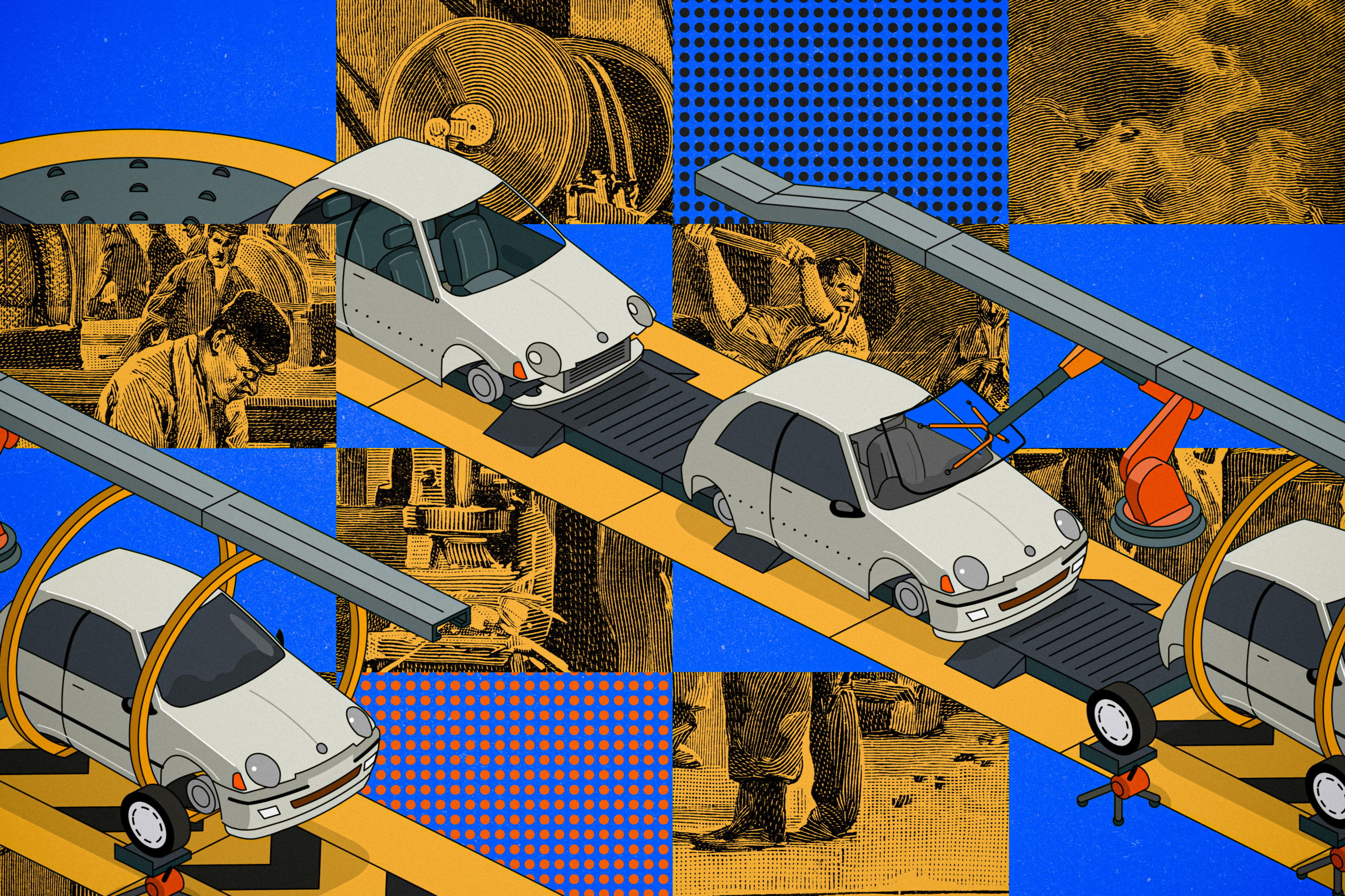Tech News
Why GigaCloud Technology Inc. (GCT) Dipped More Than Broader Market Today – Yahoo Finance

GigaCloud Technology Inc. (GCT) closed at $31.02 in the latest trading session, marking a -1.8% move from the prior day. This change lagged the S&P 500's daily loss of 0.95%. Meanwhile, the Dow lost 1.09%, and the Nasdaq, a tech-heavy index, lost 0.84%.
Coming into today, shares of the company had lost 14.25% in the past month. In that same time, the Business Services sector lost 0.45%, while the S&P 500 gained 1.78%.
The investment community will be paying close attention to the earnings performance of GigaCloud Technology Inc. in its upcoming release. The company's earnings per share (EPS) are projected to be $0.51, reflecting a 30.77% increase from the same quarter last year. At the same time, our most recent consensus estimate is projecting a revenue of $235 million, reflecting an 83.88% rise from the equivalent quarter last year.
For the annual period, the Zacks Consensus Estimates anticipate earnings of $2.58 per share and a revenue of $1.11 billion, signifying shifts of +12.17% and +57.07%, respectively, from the last year.
Investors should also note any recent changes to analyst estimates for GigaCloud Technology Inc. Recent revisions tend to reflect the latest near-term business trends. Therefore, positive revisions in estimates convey analysts' confidence in the company's business performance and profit potential.
Research indicates that these estimate revisions are directly correlated with near-term share price momentum. Investors can capitalize on this by using the Zacks Rank. This model considers these estimate changes and provides a simple, actionable rating system.
Ranging from #1 (Strong Buy) to #5 (Strong Sell), the Zacks Rank system has a proven, outside-audited track record of outperformance, with #1 stocks returning an average of +25% annually since 1988. Over the last 30 days, the Zacks Consensus EPS estimate has moved 15.69% higher. GigaCloud Technology Inc. currently has a Zacks Rank of #1 (Strong Buy).
Valuation is also important, so investors should note that GigaCloud Technology Inc. has a Forward P/E ratio of 12.24 right now. This signifies a discount in comparison to the average Forward P/E of 24.6 for its industry.
The Technology Services industry is part of the Business Services sector. This group has a Zacks Industry Rank of 95, putting it in the top 38% of all 250+ industries.
The Zacks Industry Rank is ordered from best to worst in terms of the average Zacks Rank of the individual companies within each of these sectors. Our research shows that the top 50% rated industries outperform the bottom half by a factor of 2 to 1.
You can find more information on all of these metrics, and much more, on Zacks.com.
Want the latest recommendations from Zacks Investment Research? Today, you can download 7 Best Stocks for the Next 30 Days. Click to get this free report
GigaCloud Technology Inc. (GCT) : Free Stock Analysis Report
To read this article on Zacks.com click here.
Zacks Investment Research
Market volatility is back. Investors should seek companies that are starting and increasing dividends.
In the most recent trading session, Twilio (TWLO) closed at $61.33, indicating a -0.84% shift from the previous trading day.
SHANGHAI (Reuters) -China's securities regulator issued draft rules on Friday to strengthen the supervision of company listings, delistings and computer-driven programme trading, in a move to improve the stock market and protect investors' interests. The China Securities Regulatory Commission (CSRC) will raise the bar for initial public offerings (IPOs), force unqualified companies to delist, and strengthen the oversight of high-frequency trading, according to draft rules put out for public opinion.
This is what could happen next to Nvidia shares.
San Francisco has long been feared to be falling into a doom loop, a situation where taxpayers leaving the crime-ridden city results in lower tax revenues leading to cuts in services and rising taxes, making it even less desirable to live in. It can be especially devastating when a community's essential businesses, such as grocery stores, decide to leave. San Francisco experienced this last year when Amazon.com Inc. (NASDAQ:AMZN)-owned Whole Foods Market Inc. shut down its flagship store in the
Advanced Micro Devices is diving into the artificial intelligence (AI) industry.
Here's how to stake your claim on the AI gold rush.
Great investing minds appear to be thinking alike about two top AI stocks.
Marathon Digital and Coinbase could both heat up as the crypto winter ends.
Rivian is going to have a hard time digging out of this hole.
These dividend payers have a long history of steady dividend payout raises, and they both offer yields above 6% at recent prices.
Stocks have lost touch with reality, the microchip buying frenzy won't last, and stagflation is in the cards, Jesse Felder said.
Investors in a hedge fund from Baker Bros. Advisors recently received one of the largest windfalls ever following Pfizer’s purchase of Seagen.
Some well-known stocks have been noticeably absent from the market rally.
Monthly dividend stocks let you experience the joy of getting paid 12 times a year.
Investors sweating over a market pullback can relax for now, as numerous factors are providing a tailwind for stocks, Goldman's John Flood said.
You can own a basket of tremendously successful stocks with this ETF.
There's no guarantee these stocks will double by 2030, but their growth prospects look great.
If you are looking to add dividend-paying stocks to your ETF portfolio, here are three of the best ways to do it.
Intel has announced updates about its upcoming artificial intelligence accelerator, Gaudi 3.
Tech News
North Carolina Assistive Technology Program | NCDHHS – NCDHHS
State Government websites value user privacy. To learn more, view our full privacy policy.
Secure websites use HTTPS certificates. A lock icon or https:// means you’ve safely connected to the official website.
Main menu
Want to learn how technology can help you connect to people, activities and your community? Don’t miss our Accessibility for All live event series, every Thursday at 11:30 a.m.
NCATP offers AAC and AT assessment services for children and adults.
NCATP recommends low tech devices to meet the needs of our consumers.
NCATP has 9 centers that serve North Carolinians from the mountains to the coast.
NCATP provides demonstrations of assistive technology and short-term loans of equipment. Our staff are available to assist you.
Keep up with the events hosted by NCATP through our Events Calendar.
Don’t miss our Adaptive Recreation and Active Living Resource Fairs coming up soon!
Learn about local resources and get hands-on experience with accessible equipment at an Adaptive Recreation and Active Living Resource Fair near you. All fairs are free and open to the public. We encourage everyone interested in staying active and accessible recreation and leisure activities to attend. More information.
The North Carolina Assistive Technology Program (NCATP) is a state and federally funded program that provides assistive technology services statewide to people of all ages and abilities. NCATP leads North Carolina’s efforts to carry out the federal Assistive Technology Act of 2004 by providing device demonstration, short-term device loans, and reutilization of assistive technology. We promote independence for people with disabilities through access to technology.
Sign up for a BEAM Tour
NCATP Administrative Offices
2801 Mail Service Center
Raleigh, NC 27699-2801
Phone: 919-855-3500
Confidential Fax: 919-715-1776
NCATP is partially funded by Grant Number 1601NCSGAT from the Administration for Community Living. The contents of this website are solely the responsibility of the authors and do not necessarily represent the official views of the Administration for Community Living.
Administration of Community Living Award Information
NC Department of Health and Human Services
2001 Mail Service Center
Raleigh, NC 27699-2000
Customer Service Center: 1-800-662-7030
Visit RelayNC for information about TTY services.
Tech News
Does technology help or hurt employment? | MIT News | Massachusetts Institute of Technology – MIT News

Suggestions or feedback?
Images for download on the MIT News office website are made available to non-commercial entities, press and the general public under a Creative Commons Attribution Non-Commercial No Derivatives license. You may not alter the images provided, other than to crop them to size. A credit line must be used when reproducing images; if one is not provided below, credit the images to “MIT.”
This is part 2 of a two-part MIT News feature examining new job creation in the U.S. since 1940, based on new research from Ford Professor of Economics David Autor. Part 1 is available here.
Ever since the Luddites were destroying machine looms, it has been obvious that new technologies can wipe out jobs. But technical innovations also create new jobs: Consider a computer programmer, or someone installing solar panels on a roof.
Overall, does technology replace more jobs than it creates? What is the net balance between these two things? Until now, that has not been measured. But a new research project led by MIT economist David Autor has developed an answer, at least for U.S. history since 1940.
The study uses new methods to examine how many jobs have been lost to machine automation, and how many have been generated through “augmentation,” in which technology creates new tasks. On net, the study finds, and particularly since 1980, technology has replaced more U.S. jobs than it has generated.
“There does appear to be a faster rate of automation, and a slower rate of augmentation, in the last four decades, from 1980 to the present, than in the four decades prior,” says Autor, co-author of a newly published paper detailing the results.
However, that finding is only one of the study’s advances. The researchers have also developed an entirely new method for studying the issue, based on an analysis of tens of thousands of U.S. census job categories in relation to a comprehensive look at the text of U.S. patents over the last century. That has allowed them, for the first time, to quantify the effects of technology over both job loss and job creation.
Previously, scholars had largely just been able to quantify job losses produced by new technologies, not job gains.
“I feel like a paleontologist who was looking for dinosaur bones that we thought must have existed, but had not been able to find until now,” Autor says. “I think this research breaks ground on things that we suspected were true, but we did not have direct proof of them before this study.”
The paper, “New Frontiers: The Origins and Content of New Work, 1940-2018,” appears in the Quarterly Journal of Economics. The co-authors are Autor, the Ford Professor of Economics; Caroline Chin, a PhD student in economics at MIT; Anna Salomons, a professor in the School of Economics at Utrecht University; and Bryan Seegmiller SM ’20, PhD ’22, an assistant professor at the Kellogg School of Northwestern University.
Automation versus augmentation
The study finds that overall, about 60 percent of jobs in the U.S. represent new types of work, which have been created since 1940. A century ago, that computer programmer may have been working on a farm.
To determine this, Autor and his colleagues combed through about 35,000 job categories listed in the U.S. Census Bureau reports, tracking how they emerge over time. They also used natural language processing tools to analyze the text of every U.S. patent filed since 1920. The research examined how words were “embedded” in the census and patent documents to unearth related passages of text. That allowed them to determine links between new technologies and their effects on employment.
“You can think of automation as a machine that takes a job’s inputs and does it for the worker,” Autor explains. “We think of augmentation as a technology that increases the variety of things that people can do, the quality of things people can do, or their productivity.”
From about 1940 through 1980, for instance, jobs like elevator operator and typesetter tended to get automated. But at the same time, more workers filled roles such as shipping and receiving clerks, buyers and department heads, and civil and aeronautical engineers, where technology created a need for more employees.
From 1980 through 2018, the ranks of cabinetmakers and machinists, among others, have been thinned by automation, while, for instance, industrial engineers, and operations and systems researchers and analysts, have enjoyed growth.
Ultimately, the research suggests that the negative effects of automation on employment were more than twice as great in the 1980-2018 period as in the 1940-1980 period. There was a more modest, and positive, change in the effect of augmentation on employment in 1980-2018, as compared to 1940-1980.
“There’s no law these things have to be one-for-one balanced, although there’s been no period where we haven’t also created new work,” Autor observes.
What will AI do?
The research also uncovers many nuances in this process, though, since automation and augmentation often occur within the same industries. It is not just that technology decimates the ranks of farmers while creating air traffic controllers. Within the same large manufacturing firm, for example, there may be fewer machinists but more systems analysts.
Relatedly, over the last 40 years, technological trends have exacerbated a gap in wages in the U.S., with highly educated professionals being more likely to work in new fields, which themselves are split between high-paying and lower-income jobs.
“The new work is bifurcated,” Autor says. “As old work has been erased in the middle, new work has grown on either side.”
As the research also shows, technology is not the only thing driving new work. Demographic shifts also lie behind growth in numerous sectors of the service industries. Intriguingly, the new research also suggests that large-scale consumer demand also drives technological innovation. Inventions are not just supplied by bright people thinking outside the box, but in response to clear societal needs.
The 80 years of data also suggest that future pathways for innovation, and the employment implications, are hard to forecast. Consider the possible uses of AI in workplaces.
“AI is really different,” Autor says. “It may substitute some high-skill expertise but may complement decision-making tasks. I think we’re in an era where we have this new tool and we don’t know what’s good for. New technologies have strengths and weaknesses and it takes a while to figure them out. GPS was invented for military purposes, and it took decades for it to be in smartphones.”
He adds: “We’re hoping our research approach gives us the ability to say more about that going forward.”
As Autor recognizes, there is room for the research team’s methods to be further refined. For now, he believes the research open up new ground for study.
“The missing link was documenting and quantifying how much technology augments people’s jobs,” Autor says. “All the prior measures just showed automation and its effects on displacing workers. We were amazed we could identify, classify, and quantify augmentation. So that itself, to me, is pretty foundational.”
Support for the research was provided, in part, by The Carnegie Corporation; Google; Instituut Gak; the MIT Work of the Future Task Force; Schmidt Futures; the Smith Richardson Foundation; and the Washington Center for Equitable Growth.
Fast Company reporter Shalene Gupta spotlights new research by Prof. David Autor that finds “about 60% of jobs in 2018 did not exist 1940. Since 1940, the bulk of new jobs has shifted from middle-class production and clerical jobs to high-paid professional jobs and low-paid service jobs.” Additionally, the researchers uncovered evidence that “automation eroded twice as many jobs from 1980 to 2018 as it had from 1940 to 1980. While augmentation did add some jobs to the economy, it was not as many as the ones lost by automation.”
Read full story →
Read full story →
Read full story →
Read full story →
Read full story →
Read full story →
This website is managed by the MIT News Office, part of the Institute Office of Communications.
Massachusetts Institute of Technology
77 Massachusetts Avenue, Cambridge, MA, USA
Tech News
Reaction to Supreme Court decision in web design case – Spectrum News NY1

Get the best experience and stay connected to your community with our Spectrum News app. Learn More
Continue in Browser
Get hyperlocal forecasts, radar and weather alerts.
Please enter a valid zipcode.
Save
Democrats and LGBTQ+ advocates on Friday condemned a Supreme Court decision siding with a Colorado web designer who argued she should be able to refuse to build wedding websites for same-sex couples. Republicans, meanwhile, praised the ruling as a victory for religious freedom.
In a 6-3 decision, the court ruled that a Colorado law that forbids businesses open to the public from discriminating against gay people violated web designer Lorie Smith’s free-speech rights. Smith, who owns the graphic design firm 303 Creative, argued that working with same-sex couples would go against her Christian faith.
President Joe Biden called the ruling “disappointing” because he said it undermines that “no person should face discrimination simply because of who they are or who they love.”
While the decision only applies to businesses that perform creative services, Biden said he fears it could “invite more discrimination against LGBTQI+ Americans.”
The president added that his administration remains committed to working with federal law enforcement to protect Americans from discrimination based on gender identity or sexual orientation and will work with states to combat attempts to roll back civil rights protections.
“When one group’s dignity and equality are threatened, the promise of our democracy is threatened and we all suffer,” Biden said.
Senate Majority Leader Chuck Schumer, D-N.Y., called the ruling “a giant step backward for human rights and equal protection in the United States.”
“Refusing service based on whom someone loves is just as bigoted and hateful as refusing service because of race or religion,” he said in a statement. “And this is bigotry that the vast majority of Americans find completely unacceptable.”
Kelley Robinson, president of the Human Rights Campaign, an LGBTQ+ advocacy group, called the decision “dangerous” because it will give “some businesses the power to discriminate against people simply because of who we are.”
“People deserve to have commercial spaces that are safe and welcoming,” she said. “This decision continues to affirm how radical and out-of-touch this Court is.”
Rep. Robert Garcia, D-Calif., who is openly gay, called it “a very dark day for our community.”
“This is a devastating ruling for the LGBTQ+ community,” he said in an interview with MSNBC. “We just spent a month celebrating, trying to uplift pride. It’s already a very dark time for this community, where you have attacks happening on our community every day in Congress, in state legislatures. And to have this happen by a true extreme activist court to roll back a key protection against discriminating our community is shameful.
Rep. Bonnie Watson Coleman, D-N.J., also attacked the conservative-majority court while noting the case involved a hypothetical situation. Smith has never designed wedding websites. She argued she wants to expand her business but was concerned about running afoul of the Colorado law.
“This SCOTUS is out of control,” Coleman tweeted. “It’s now taking made up cases in order to push a radical agenda that is out of touch with the vast majority of the American people.”
Rep. Ayanna Pressley, D-Mass., meanwhile, directed a supportive tweet toward the LGBTQ community.
“Despite yet another callous ruling from this extreme Supreme Court, I want our LGBTQ siblings to know: We see you. We love you. We won’t stop fighting for you,” she wrote.
But Kristen Waggoner, president and CEO of the Alliance Defending Freedom, a conservative Christian legal advocacy group, said in a statement the Supreme Court made the right decision. ADF attorneys, including Waggoner, represented Smith in the case.
“The U.S. Supreme Court rightly reaffirmed that the government can’t force Americans to say things they don’t believe,” Waggoner said. “The court reiterated that it’s unconstitutional for the state to eliminate from the public square ideas it dislikes, including the belief that marriage is the union of husband and wife.
“Disagreement isn’t discrimination, and the government can’t mislabel speech as discrimination to censor it,” she added.
Sen. Ted Cruz, R-Texas, said laws should not compel business owners to use their speech in ways that contradict their faith.
“This law wasn’t just a threat to Christians either,” Cruz said in a statement. “Should a Muslim artist be compelled by the government to draw the image of Muhammed? Should Jewish artists be forced to create art that is antisemitic?”
On Twitter, Sen. Lindsey Graham, R-S.C., added, “Participating in commerce does not mean you should have to abandon your faith and individuals should not be compelled, by government, to act counter to their faith.”
Former Vice President Mike Pence, who is running for the Republican presidential nomination in 2024, said in a tweet, “Today Faith Won!”
“Freedom of Religion is the bedrock of our Constitution,” he wrote. “Today’s decision by the Supreme Court is a victory for the Religious Liberty of every American of every faith to live, work and worship according to their faith and conscience!
And former Ambassador to the United Nations Nikki Haley, a Republican who is also running for president, said she’s “glad we have a Supreme Court that respects our Constitution.”
“Unlike in other countries, we don’t force our citizens to express themselves in ways that conflict with their religious beliefs. It’s called the First Amendment,” Haley said in a statement.
-

 General Knowledge2 years ago
General Knowledge2 years agoList of Indian States and Capital
-

 General Knowledge2 years ago
General Knowledge2 years agoList Of 400 Famous Books and Authors
-

 Important Days4 years ago
Important Days4 years agoImportant Days of Each Month
-

 General Knowledge2 years ago
General Knowledge2 years agoCountries and their National Sports
-

 General Knowledge3 years ago
General Knowledge3 years agoCountry Capital and Currency
-

 Important Days3 years ago
Important Days3 years agoHoli
-

 General Knowledge2 years ago
General Knowledge2 years agoList of Indian President
-

 General Knowledge2 years ago
General Knowledge2 years agoList of Indian Vice President











